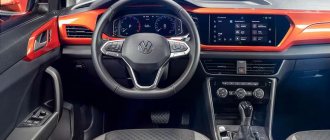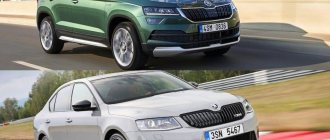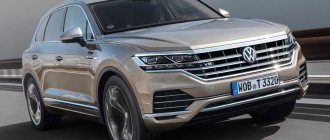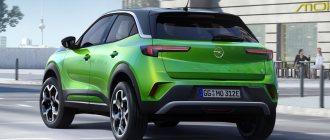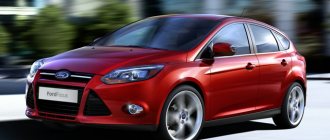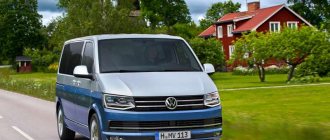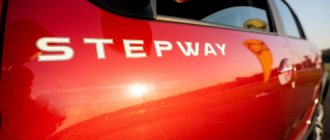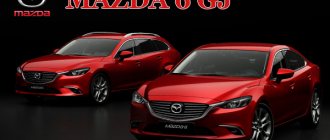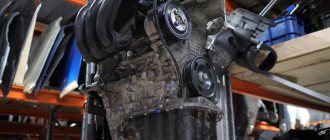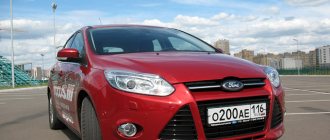Taste the rainbow
T‑Cross is a little rebel from a respectable family. Under the supervision of his elders, he puts on a serious face, but the teenage devilry no, no, and even breaks through. At the stern, between the rear lights, a stylish stripe settled - as if the tattoo on the back “accidentally” sparkled from under a business jacket. In the wardrobe, among a dozen outfits, there are vibrant exterior colors - acid green, red.
The interior can be decorated with inserts with a diverging wave. If you put out the fiery colors, the interior will immediately fall into gray everyday life, but in any case, the well-calibrated ergonomics will not go away.
The interior can be decorated with inserts with a diverging wave. If you put out the fiery colors, the interior will immediately fall into gray everyday life, but in any case, the well-calibrated ergonomics will not go away.
Even though the T‑Cross is the youngest Volkswagen crossover, it also has a virtual dashboard. With all the required functionality. |
The top-end multimedia system MIB pleases with the quality of resolution and simplicity of the interface. And traditionally amuses us with remarks from standard navigation in the style of “what is your evidence?” |
As an option: at the base of the center console there is an inductive charger for smartphones. |
Components and costs
Many motorists were interested in the new Volkswagen T Cross 2021 SUV, photos, as well as components and technical parameters of one of the smallest crossovers. According to available information, the preliminary price for Volkswagen T Cross will be 17,500 in euro currency. The 3-cylinder turbocharged 1.0TSI engine is part of the basic configuration; its power is 95 hp.
The front-wheel drive MQB AO platform was used as a basis, which makes the new product similar to hatchbacks of famous world brands, such as the Seat Ibiza, which belongs to the 5th generation. Experts believe that the characteristics of this model indicate a worthy response to the Koreans.
The list of options has increased significantly. The base of the new crossover includes 6 trim levels, as well as 3 types of engines and gearboxes. This made it possible to create 16 different versions of the models. The equipment is decent; it’s not for nothing that the motto of German manufacturers became the words “I am much more.”
For an additional fee you can purchase a branded audio system with MP3, air conditioning, and 2-zone climate control. The interior of the cabin was developed under the direction of the famous designer Klaus Bischoff in accordance with the corporate trends characteristic of the German brand. The design of the new Volkswagen T Cross meets such epithets as stylish, original, respectable.
The car model is equipped with various variations of multimedia systems. They are equipped with a color monitor. Their diagonal is within eight inches. User convenience is also provided by the presence of a platform that allows wireless charging of a smartphone. Travel safety is achieved through LED headlights. The car is equipped with rain and snow sensors.
Functionality is also provided by adaptive cruise control. The vehicle is equipped with Beats sound, a virtual dashboard and a semi-automatic parking assistant. The standard equipment of the new car is a system that prevents frontal collisions and a function that ensures compliance with driving lanes. With this equipment you will always be safe and comfortable on the road.
Healthy eating
In Europe, the range opens with liter TSI engines with two firmware versions. The basic one boasts only 95 “horses” and is paired with a five-speed manual transmission. The case when diet is not beneficial. Even if it’s a compact crossover, it’s still hard for him to drag.
The engine range is solemnly opened by a liter three-cylinder TSI with a power of 95 or 115 hp. In the first case, it is combined only with a five-speed manual transmission, in the second - with a six-speed manual transmission or a DSG preselective.
The engine range is solemnly opened by a liter three-cylinder TSI with a power of 95 or 115 hp. In the first case, it is combined only with a five-speed manual transmission, in the second - with a six-speed manual transmission or a DSG preselective.
Whether it’s the next step of 115 forces. This T‑Cross drives more fun and hits high notes with three-cylinder “bundles” quite relishly. And it doesn’t matter which gearbox is paired with it - a six-speed manual or a seven-speed DSG.
Diesel is also available. Like the base TSI, it only has 95 horsepower, but what a life-giving moment it makes! The diesel engine pulls smoothly even from low speeds. Newton meters are evenly smeared throughout the tachometer. The picture is slightly spoiled only by the constant rattling of the tractor, but the consumption of five liters per hundred makes you feel awkward that you have found fault with something at all.
Come on, T-Cross, quickly cross our border! Exchange the exotic liter TSI for something familiar and native, 1.6 liters, with MPI letters. Try the regular six-speed automatic. All you have to do is keep the price at an adequate level, and then you will do what Ford, Toyota and Nissan failed to do - you will squeeze out the Creta and Capture, which have crushed the segment. Even without fancy “shoes” and expensive Beats headphones, this young man has matured.
On serpentines the T‑Cross is at ease. However, like everything built on the MQB foundation.
On serpentines the T‑Cross is at ease. However, like everything built on the MQB foundation.
| A bright SUV with a well-tuned chassis | Front wheel drive only |
| Volkswagen T-Cross | 1.0 TSI | 1.5 TSI | 1.6 TDI |
| Length / width / height / base | 4108 / 1760 / 1584 / 2551 mm | ||
| Trunk volume (VDA) | 455/ 1281 l | ||
| Engine | petrol, P3, 12 valves, 999 cm³; 85 kW/115 hp at 5500 rpm; 200 Nm at 2000–3500 rpm | petrol, P4, 16 valves, 1498 cm³; 110 kW/150 hp at 5000–6000 rpm; 250 Nm at 1500–3500 rpm | diesel, P4, 16 valves, 1598 cm³; 70 kW/95 hp at 3250 rpm; 250 Nm at 1500 rpm |
| Acceleration time 0–100 km/h | 10.2 s | 7.8 s | 12.0 s |
| Maximum speed | 193 km/h | 220 km/h | 181 km/h |
| Fuel/fuel reserve | AI-95 / 40 l | AI-95 / 40 l | DT / 40 l |
| Fuel consumption: combined cycle | 4.9 l/100 km | n.d. | n.d. |
| Transmission | front-wheel drive; P7 | front-wheel drive, P7 | front-wheel drive; M6 |
Test of the smallest Volkswagen crossover - T‑Cross
First test of Volkswagen Taos. No longer a Karok, not yet a Tiguan
Crossovers in the lowest price segment are the most popular product on the Russian market. In a class dominated by the Creta and Karoq, Volkswagen has not yet had its own representative. From now on it exists: meet the Taos, which in the “top” is a million cheaper than the Tiguan.
Of course, we won’t pretend and invent fables, but let’s say it straight: yes, the new product on the market - Volkswagen Taos - is the same Skoda Karoq, built on the MQB platform with the same wheelbase length of 2638 mm, but flavored with sauce German In short, it has a different appearance, its own interior, different configurations, colors and options. The goal of Taos is to wedge itself between the Karok and Tiguan in the niche of those buyers who are bored by the Skoda design and do not have enough money for the “older” Volkswagen. Will it work?
Such a little Tiguan! Even with a more aggressive “face” and pronounced squared wheel arches. And the plastic body kit is good all around! But is it only us who think that the impressively sized Taos optics seem to have been stolen from a larger model? Don't you recognize the Audi Q5 or Q7 of the previous generation from the rear? Front matrix headlights IQ.Light are included only in the maximum configuration
On the one hand, it may seem that they are stupidly trying to sell us the same car - Skoda Karoq - but in a new wrapper and at a higher price (by about 70,000 rubles in medium trim levels). The same plant in Nizhny Novgorod, the same chassis, the same 150-horsepower 1.4 TSI turbo engine, which is combined with either an 8-speed automatic transmission on front-wheel drive cars, or a 7-speed robotic transmission on all-wheel drive versions. Like the Karoq, there is a starting modification with a naturally aspirated 110-horsepower engine with a manual transmission (yes, Skoda didn’t have an automatic transmission at the beginning of sales either), but, let’s be honest, are there many people interested in such a thing? In general, it seems like “the same eggs, side view.” But it is precisely the appearance of the crossover that differs from Volkswagen.
From the rear, it is especially noticeable that the Taos has a slight problem with the proportions: the lights are like a nose that grows for seven people, and the 17-inch wheels, on the contrary, are lost in the huge wheel arches. Black roof rails combine well with a body kit made of unpainted plasticIt is clear that Taos is primarily aimed at a younger audience. It is to them that the now fashionable appearance with a slight touch of aggression, with a heavy “muzzle”, square wheel arches and a rear end with huge lights and an elaborate pseudo-diffuser is addressed. Or maybe I'm too old and just don't understand the positivity of this sentiment and can't appreciate the bright orange color available for Taos and the similarly colored massive front panel of the special edition Joy! However, it must be admitted that in any color (and, by the way, there are just as many of them as the Karoka) the Taos looks clearly more cheerful than the Skoda, which means that it is on target.
In the version of Joy! (pictured) The interior is effectively enlivened by a full-width orange insert on the front panel, which even creeps onto the doors. The 10-inch central screen fits very well to the right of the digital instrument panel. The two-zone “climate” unit has three classic “knobs”, but is located a bit low. The multifunctional steering wheel is very pleasant, almost like a Golf. The quality of finishing materials is no better than that of the single-platform Karoq; there are not enough stars in the sky. Navigation in Taos - only through Yandex.Maps or from your phone via Apple CarPlay
It's the same story in the interior. There is no cardinal superiority in the quality of materials, but the architecture is slightly different, the dashboard and central display clearly fall into place, the steering wheel delights not only with its design, but also with its convenience, and that bright insert of the Joy version! greatly enlivens this salon. It's a pity that Joy! The "goodies" of the Exclusive package are not included - adaptive LED headlights, combined seat trim, a "tidy" with different views, a front camera and active safety systems. But even without them, Taos is packaged quite decently, the ergonomics are fine, although some may still not have enough height adjustment for the steering wheel. But we still have a number of questions. Why is there hard plastic even on the front doors (even the Karok is soft!)? Why is the Sport mode not displayed on the drive mode dial, although it can be activated through the display? Why was the always logical Volkswagen multimedia menu replaced this time with a new one, which is inconvenient to use and constantly requires you to search for something? But those sitting in the back don’t need to think about anything: Volkswagen inherited from its “donor” not only a very spacious heated rear row, but also a spacious 500-liter trunk with side compartments.
The front seats look simple, “rag”, but with a quite successful profile. Combined trim and more developed “ears” are available only in the “top” Exclusive version, as is the dashboard with several Active Info Display options. On the central tunnel there are two deep cup holders with holders, a compartment for a smartphone, key and cards, a “puck” for selecting the driving mode, an electronic “handbrake” with the Auto Hold system and an engine start button. In the depths there are two USB-C connectors, a little higher there is an ideal climate control unitAs you probably know, in Europe Volkswagen has not used 1.4 TSI turbo engines for several years now; instead, 1.5 liter Evo series engines have appeared under the hoods of a wide variety of models - the same power, but more economical and “cleaner”. But in Russia they install “old” engines, you don’t have to think about the environment yet, and therefore the 1.4 TSI is our “Volkswagen” everything. Another “our everything” until recently was the “wet” 6-speed DSG transmission (DQ250) for versions with all-wheel drive. But in July Karoq swapped it out for what is said to be a more advanced DQ381 unit with seven gears. Accordingly, Taos is already equipped with just such a gearbox (based on the proven DQ500). It is also “wet”, can withstand torque up to 420 Nm, is equipped with two oil pumps (mechanical and electric, which turn on at increased loads and in start-stop mode and prevent overheating in traffic jams. Theoretically, this is a more reliable and at the same time fast and economical version of the DQ500 .
The second row of the Taos is quite spacious if your height does not exceed 185 cm, and the armrest is only available in the richest Exclusive version. There are also heated seats, separate air vents and two USB-C connectors. The central tunnel is a bit high. For a car of this size, the Taos has a fairly spacious trunk - 500 liters. Under the floor there is a “dokatka”. The backrests fold in a 2:3 ratio with a noticeable step, and there is a hatch for long items. The maximum volume of the luggage compartment is not declared, but, for example, for the same Karoq it is 1585 litersBut, as often happens, everything was beautiful in words, but in reality it turned out to be not so rosy. It was with the new DSG that we had some misunderstanding. In “drive”, the thoughtfulness of this unit is as if half of the herd of 150 “horses” had run away. In Sport mode, Taos, as expected, becomes more nimble, begins to respond adequately to the gas, but another misfortune appears - noticeable jolts when shifting into 3rd-4th-5th gear. A little later, in light off-road conditions, we caught another “bug”: when starting uphill with a load (for example, when hanging one of the wheels), the electronics do not allow the required speed to develop for a couple of seconds. Frankly, it’s surprising that Volkswagen specialists didn’t pay attention to this. Nevertheless, we are sure that the problem is in the “software” of the new gearbox - it needs a good “brain” adjustment.
The combination of the 1.4-liter “all-Volkswagen” turbo engine is well known to us, both in combination with the DSG “robot” and with the 8-speed “automatic” Aisin. Neither version can be accused of lack of dynamics. And the ride quality of the Taos is not bad, considering such a short wheelbase and 17-inch wheel size
Such problems are alien to the front-wheel drive version. The same engine is paired with an 8-speed Aisin automatic transmission, and this combination provides decent smoothness of shifts, although it does not differ in the rate of fire of the DSG even in sport mode. In addition, the lighter crossover, not burdened with all-wheel drive and a rear “multi-link,” even accelerates “according to the passport” a little faster, and consumes less gasoline. For those who use the car only in the city and on asphalt, the 2WD option seems preferable at the moment. At least until the new DSG is “finished” for Taos.
You won’t notice any significant differences in road behavior or smoothness between these two versions. It is clear that on off-road or slippery surfaces the 4Motion modification is definitely more stable and preferable, and the special Off-Road mode makes it easy to deal with diagonal hanging or climb rocky river beds, but in terms of ride smoothness and level of comfort they are almost indistinguishable and, it must be said, very good. Over the course of two days, we drove a couple of hundred kilometers on dirt roads of varying degrees of roughness, and Taos held up to the blow very well. Well, we knew before that all cars on the MQB platform handle corners well. And Taos was no exception.
You can break the air for as long as you like, arguing about “why do we need Taos if we have Karoq?” Still, Volkswagen and Skoda are different companies, although they are part of the same concern. Volkswagen, of course, could not quietly stand by while Skoda nibbled its huge piece of the corporate pie. Moreover, the production capacity in Nizhny Novgorod allows. We have no particular doubts about the success of Taos: the price is adequate in our realities, the car is pleasant and practical, although not without some shortcomings. And still, I’m sure there will be those who would prefer the brighter appearance of Taos, the original interior and the VW nameplate on the grille in exchange for a small overpayment compared to the Karok.
The base model is the unique front-wheel drive Taos with a naturally aspirated 1.6-liter 110-horsepower MPI engine with a manual transmission in the initial Respect version for 1,626,900 rubles. The same equipment, but with a 1.4-liter turbo engine (150 hp), all-wheel drive and a “robot” costs 1,856,900 rubles. But the front-wheel drive version with the 1.4 TSI engine is available only from the Status version - from 1,906,900 rubles. In a special package Joy! Taos 1.4 costs 2,004,900 rubles with front-wheel drive and 2,104,900 with all-wheel drive. The most expensive Taos Exclusive 4WD will cost 2,199,000 rubles without taking into account the metallic color (18,500 rubles), packages and options (with them almost 180,000 rubles more expensive)
Technical characteristics of Volkswagen Taos 1.4 (manufacturer data)
| 1.4TSI | 1.4 TSI 4×4 | |
| Body | ||
| Type | Station wagon (SUV) | |
| Number of seats/doors | 5/5 | |
| Engine | ||
| Type | Petrol, direct injection and turbocharged | |
| Engine location | Front transverse | |
| Number and arrangement of cylinders | 4, in a row | |
| Working volume, cubic meters cm | 1395 | |
| Power, hp at rpm | 150/5000 | |
| Torque, Nm at rpm | 250/1500–4000 | |
| Transmission | ||
| Drive unit | Front | Full |
| Transmission | 8-automatic | 7-RCP (DSG) |
| Brakes | ||
| Front | Ventilated disc | |
| Rear | Disk | |
| Suspension | ||
| Front | Independent, spring (McPherson) | |
| Rear | Semi-independent, spring (twisted beam) | Independent, spring (multi-link) |
| Dimensions, volume, weight | ||
| Length/width/height, mm | 4417x1841x1602 | |
| Wheelbase, mm | 2638 | |
| Ground clearance, mm | 177 | 175 |
| Curb weight, kg | 1354 | 1467 |
| Fuel tank volume, l | 55 | |
| Trunk volume, l | 500/n. d. | |
| Tire size | 215/55 R17 | |
| Dynamic characteristics | ||
| Maximum speed, km/h | 200 | 190 |
| Acceleration to 100 km/h, sec. | 8,8 | 8,9 |
| Fuel consumption, l/100 km | ||
| Combined cycle | 7,0 | 8,0 |
| CO2 emissions, g/km, eq. Class | N.D./Euro-5 | 181/Euro-5 |
| Cost of the car, rub. | ||
| Basic equipment | 1 906 900 | 1 856 900 |
